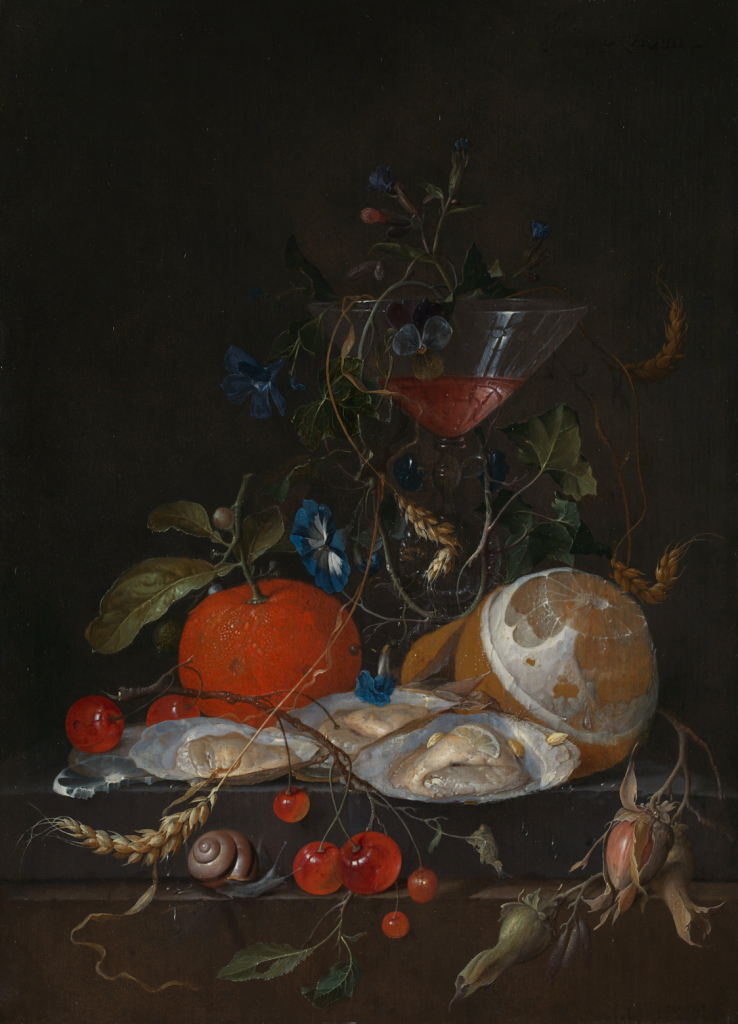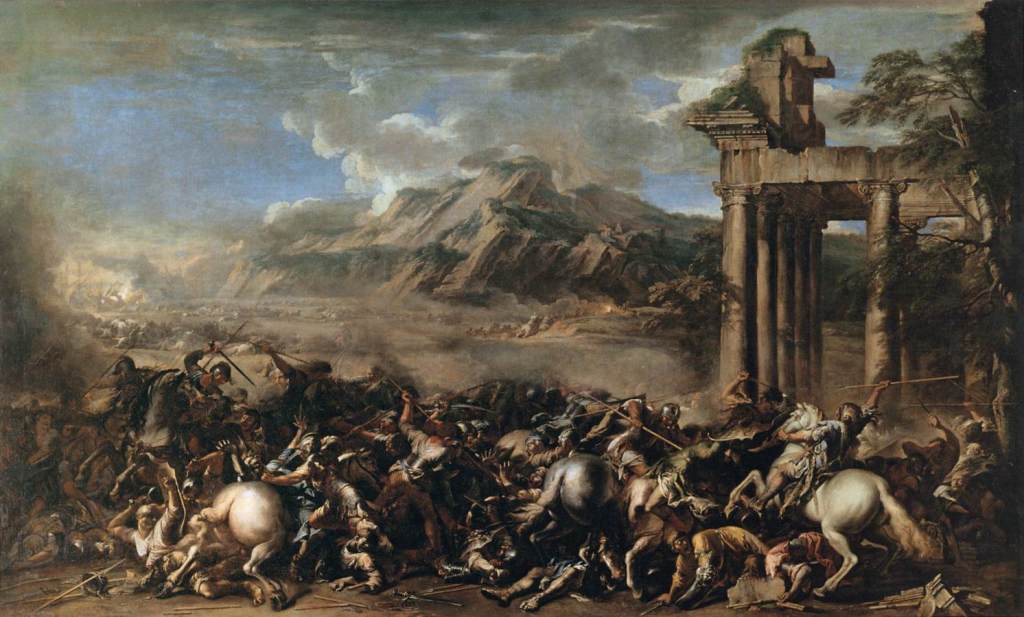Reynolds often mentioned the idea of elevation. By this he seems to have meant not only a translation into visual vocabulary but also an improvement of the subject. It is this elevation that Michelangelo Buonarroti had in mind when he said that Titian’s work was poor in design (or drawing). The artist and historian Giorgio Vasari, referrring to himself in the third person, described how he and Michelangelo had visited Titian who, at the time, was occupying a temporary studio in the Belvedere, Rome:

Ceiling of the Sistine Chapel, Rome c 1510
Michelangelo Buonarrotti (1475 – 1564)
This shows the clarity of drawing and the sense of beauty that Michelangelo felt was lacking in Titian’s painting, despite its many strengths.

Danaë, 1544-46
Praised by Michelangelo for being true to life, with beautiful colour, painted with a fine spirit and a lively and entrancing style. However Michelangelo thought it lacked the beautiful sense of proportion that it would have had if Titian had studied more from ancient works of art.
Then one day Michelangelo and Vasari went along to visit Titian in the Belvedere, where they saw a picture he had finished of a nude woman, representing Danaë, who had in her lap Jove transformed into a rain of gold; and naturally, as one would do with the artist present, they praised it warmly.
Giorgio Vasari (1511 – 1574),
After they had left they started to discuss Titian’s method and Buonarroti commended it highly, saying that his colouring and his style pleased him very much but that it was a shame that in Venice they did not learn to draw well from the beginning and that those painters did not pursue their studies with more method.
For the truth was, he went on, that if Titian had been assisted by art and design as much as he was by nature, and especially in reproducing living subjects, then no one could achieve more or work better, for he had a fine spirit and a lively and entrancing style.
To be sure, what Michelangelo said was nothing but the truth; for if an artist has not drawn a great deal and studied carefully selected ancient and modern works he cannot by himself work well from memory or enhance what he copies from life, and so give his work the grace and perfection of art which are beyond the reach of nature, some of whose aspects tend to be less than beautiful.
Lives of the Artists (1568),
George Bull (Translator)
https://www.penguin.co.uk/books/351/35128/lives-of-the-artists/9780141919973.html
In Reynolds’s view, the elevated style represented the highest achievement possible in the art of painting. However, this style was so difficult to acquire that it was open only those who had extraordinary talent, energy, and determination – artists such as Michelangelo and Raphael. For those who did not have the superlative power of these rare individuals, other styles were available – though less elevated. These Reynolds called the lower departments of painting.

Minerva protects Pax from Mars (‘Peace and War’) – 1629-30
Reynolds made some fine distinctions. For example he mentioned that Rubens had not been capable of the highest style, and yet had produced some wonderful paintings. Rubens had been able to do this because he was able to express a complete mind, coherent and energetic. Reynolds recognised that he himself did not have what it took to paint in the most elevated style. He was content to direct himself very largely to portraiture instead – in which he was able to paint some masterpieces.
The higher the style of painting, the more the attention of the viewer would be directed to abstract elements, line, form, tone and colour; in combination with the subjects which could be illustrated with these elements. The viewer was not to be distracted by less abstract achievements, for example a painter’s demonstration that he could paint an item of porcelain or some flowers so realistically that the painting would look almost like a photograph. This type of achievement had its place in the lower departments of art, but could be a distraction if and when the viewer’s attention was to be directed to the higher levels of thinking and feeling.

The detail show similar subjects treated by a Dutch painter (de Heem) at left, and by Rubens, a painter whose style is grander. – more schematic and less photographic.

Still Life – about 1664-5
This is much closer to a photograph than a picture in the Grand Style, and yet which departs from reality sufficiently to produce a wonderful quality of light and colour across the picture which would be impossible in a photograph.

Detail from – Minerva protects Pax from Mars (‘Peace and War’) – 1629-30
This still life from a very large painting shows how a still-life can be treated with more vigour than seen in a typical Dutch painting. The items are more schematic (lines around them more obvious) while the tones are closer, so that the viewer’s eye moves across the whole more easily.
So there was a range of subject-matter, with still-life as the lowest subject (Van Huysum), and history or poetical painting as the highest (the Caracci and Michelangelo). If an historical subject were to be painted in the way in which a still-life was painted, it would end up looking like a still photograph extracted from a Hollywood epic movie, not like a grand painting by Michelangelo. An illusory approach to such a subject would cause the viewer to notice the illusion more than the form and movement, (and the psychological values which go with them). Painting would be reduced to a kind of trickery, rather than a way in which to strike the imagination of the viewer – or to ‘warm the heart’ as Reynolds put it.
In later years, Turner and Constable elevated the art of landscape painting in ways which Reynolds had not anticipated. Similarly Braque and Picasso partially elevated the art of still-life painting, by destroying all sense that materials were being imitated photographically, thus forcing the viewer to contemplate form and shape instead.
Here are some quotations in which Reynolds gave his thoughts on Elevation:
It is to Michel Angelo that we owe even the existence of Raffaelle; it is to him Raffaelle owes the grandeur of his style. He was taught by him to elevate his thoughts, and to conceive his subjects with dignity. (Discourse 5)
A faithful picture of a mind …if it be marked with that spirit and firmness… will …be more striking than a combination of excellencies that do not seem to unite well together… (Discourse 5)

Heroic Battle (ca. 1652-1664),
oil on canvas, 214 x 351 cm. Louvre
Salvator Rosa… gives us a peculiar cast of nature, which,… though it has nothing of that elevation and dignity which belongs to the grand style, yet has that sort of dignity which belongs to savage and uncultivated nature: but what is most to be admired in him is the perfect correspondence which he observed between the subjects which he chose and his manner of treating them. (Discourse 5)
A mind enriched by an assemblage of all the treasures of ancient and modern art will be more elevated and fruitful in resources, in proportion to the number of ideas which have been carefully collected and thoroughly digested. (Discourse 6)
The nobility or elevation of all arts …consists in adopting this enlarged and comprehensive idea; and all criticism built upon the more confined view of what is natural may properly be called shallow criticism, rather than false: its defect is, that the truth is not sufficiently extensive. (Discourse 7)
As the artist forms his vocabulary based on ideal forms (say cylinder, sphere and cone) it may be natural for him to develop ideal figures. The 18thC and 19thC writers often made little distinction between translating the scene into a visual vocabulary (‘copying nature’), and improving the scene itself.
Some artists, such as Caravaggio distinguished themselves by painting people who in earlier days would have been considered too ugly to be fit subjects for art. Rembrandt went even further in this direction, sometimes emphasising aspects of his figures which were far from ideal. At the furthest extreme were caricaturists, perhaps best exemplified by William Hogarth. He was able to paint both the sublime and the ridiculous, along with everything in between. All these great artists used large visual vocabularies, but only some chose to idealise their figures.
The relationship of Rembrandt to the great artists of the Italian Renaissance is explored in Kenneth Clark’s book (1966). The book makes it clear that Rembrandt was consciously taking the Grand style as a basis, and purposely varying from it – though not as far as is often supposed.
P40: But although some of Rembrandt’s greatest paintings seem to derive their vital magic from a clairvoyant sympathy with the gothic past, they owe their air of timeless authority to an underlying knowledge of the classical tradition.
Rembrandt and the Italian Renaissance (1966)
Kenneth Clark (1903-1983)
https://archive.org/details/rembrandtitalian0000clar

“Life of John the Baptist: the Baptism of Christ”, c. 1507-1513, fresco,
Chiostro dello Scalzo (a cloister), Florence.
This forms part of a series of frescos which Clark mentioned (below). They made up Wölfflin’s favourite example of Classical Art.
P75: (re:a drawing in Berlin). It appears to work its effect on our feelings by its rendering of light; its classical origins are hidden; and yet behind its luminous naturalism is a noble solemnity of design, that argues the classical tradition. From 1650 onwards many of Rembrandt’s drawings are models of the kind of classicism described by Wölfflin ; that is to say they are clear and economical, free from decorative ornament, dedicated to the episode they depict, and set in a rationally constructed space. Such a drawing as the Undutiful Servant in the Louvre shows a spareness and concentration comparable with Wölfflin’s* favourite example of Klassische Kunst, Andrea de Sarto’s frescoes in the Scalzo.
*Heinrich Wölfflin (1864 -1945) was a Swiss art historian whose classifying principles (“painterly” vs. “linear”) were influential in art history.
Rembrandt and the Italian Renaissance (1966)
Kenneth Clark (1903-1983)
https://archive.org/details/rembrandtitalian0000clar